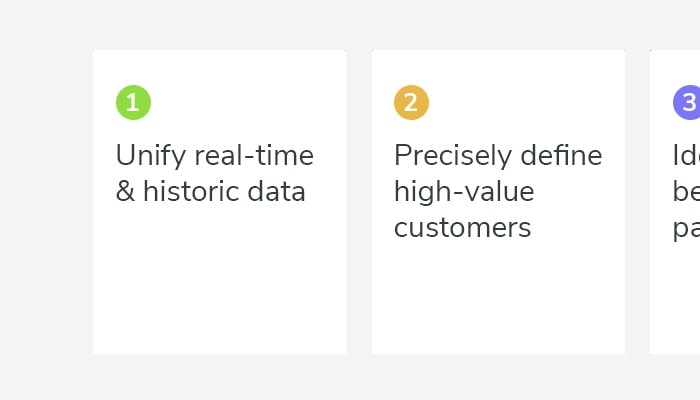The Pareto Principle & 5 Keys to Profit From High-value Relationships

Many marketers have increasingly embraced the Pareto Principle, the idea that 20 percent of their customers generate 80 percent of their revenue. Given this, it makes sense they would invest a disproportionate part of their resources marketing to their best customers, since it can have a much greater impact on revenue than indiscriminate, batch-and-blast messaging.
Now, in a world of proliferating digital touch points, brands possess more data than ever about their high-value customers. And they can use that data to both deepen their current high-value relationships and broaden their high-value customer base, by understanding:
- The needs, preferences and habits of current high-value customers, and therefore the messages that are most likely to grow those relationships.
- Where to find the next generation of high-value customers, by identifying customers with the same set of attributes as your current best customers.
In other words, they can break out of an old-fashioned, zero-sum approach to the Pareto Principle.
The problem is, many otherwise sophisticated brands can only leverage a tiny portion of the data they collect about these high-value customers. For example, they may only be able to use browsing behavior to serve up content or offers to customers based on that browsing behavior alone.
Imagine if, instead, you could combine browsing with insight into past purchases, service interactions, email responses, etc. Suddenly, you can deliver a much more refined, effective message. You can also discover other consumers who share a set of common attributes with best customers—and are therefore more likely to become great themselves.
Here is just one example of how, at ActionIQ, we helped an omni-channel fashion retailer both deepen and broaden its approach to high-value customers. The brand increased its return on marketing spend 45% by:
- Identifying high-value customers who did not require discount incentives
- Creating post-purchase journey campaigns for custom audience segments, with a special focus on their high-value customers
- Keeping high-value segments up-to-date automatically based on customers’ most recent purchase behaviors.
Here are five key steps that brands can take to transcend the Pareto Principle.
1. Unify all relevant customer data, both real-time and historic.
To understand your high-value customers, you need a comprehensive, unified view of all relevant interactions each of them has with your brand.
To do so, some brands build their own platforms with data lake and enterprise warehouse technologies. Others have embraced monolithic marketing clouds. Finally, smart hubs or customer data platforms (CDPs) can unify data from any source, enable sophisticated targeting decisioning across all that data, and then orchestrate these decisions across any channel.
2. Define high-value customers with precision.
Revenue alone is not enough to define high-value customers. Consider the following as you define the rules for your high-value customer bucket:
- Revenue vs. net margin. Some customers may only buy items that are deeply discounted and therefore contribute little to what really counts—net margin.
- “Fraud-like” bulk shoppers. Certain customers may make a single bulk purchase, but in ways that indicate they are re-sellers who actually cut into your margins.
- Customer tenure vs. current engagement. A customer you acquired five years ago may have spent much more in total than a customer you acquired in the last year. However, you need to evaluate behaviors of these shoppers within the same timeframe to ensure that your high-value bucket is representative of all of your customer cohorts.
3. Identify key patterns in the behaviors of high-value customers.
Now you can unleash marketers, aided by AI-driven insights, on all that unified data to understand the wants, needs and preferences of your high-value customers. Typically, these insights fall into three categories:
- Behaviors. Besides pure spend, you can identify other shared behavioral patterns —e.g browsing, email and/or app engagement, product affinities and connections between online and in-store activities.
- Profile analysis. Gain deeper understanding of their demographics – age, income, lifestage, household composition, geographic location, etc.
- Purchase cadence. It is important to understand their purchase frequency, whether they shop weekly/monthly or a few times a year, shop during a particular season, etc.
4. Deepen and retain current high-value relationships.
Now you can leverage those rich insights into your top customers to grow their relationship with your brand. For example,
- Behavioral patterns reveal preferred ways of interacting with your brand as well as types of content and products that drives engagement.
- Profile analysis helps you tailor voice/tone, showing you understand who you are talking to.
- Purchase cadence reveals the best times to reach out. However, effective engagement with high-value customers can also mean “not selling, just telling”—for example, regularly providing compelling content that keeps your brand top of mind for your best customers.
5. Foster new high-value relationships.
When you understand the demographics and affinities of high value customers, you can obviously develop much more targeted strategies to acquire new customers who share key attributes with them.
You can also use those insights to grow customer relationships with current customers who behave in ways similar to your best customers. And again, all that data enables you to create far more targeted, relevant campaigns that turn them into your next generation of great customers.
At the end of the day, you may find the 80:20 split predicted by the Pareto Principle still holds for your customers. However, these data-driven steps can “lift all boats” by deepening your relationship with the top 20 percent, discovering new revenue opportunities among the other 80 percent, and expanding your entire customer base by acquiring promising new customers.





